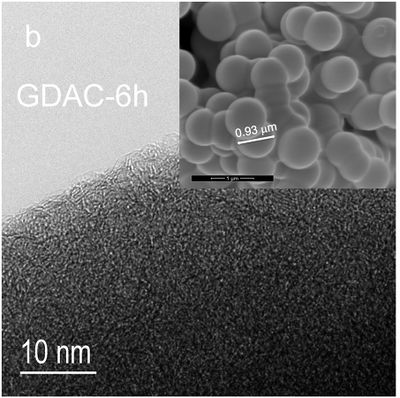Hydrothermal Carbonization: Difference between revisions
Jump to navigation
Jump to search

mNo edit summary |
m (Minor Text Formatting Fix) |
||
| (13 intermediate revisions by the same user not shown) | |||
| Line 1: | Line 1: | ||
[[Image:Hydrothermal Carbonization01.jpg|400px|thumb|right| Carbon nanoballs made from glucose via hydrothermal carbonization, that have been processed with CO<sub>2</sub> for 6 hours to change surface properties. SEM image from [https://en.wikipedia.org/wiki/University_of_Tartu University of Tartu].]] | [[Image:Hydrothermal Carbonization01.jpg|400px|thumb|right| Carbon nanoballs made from glucose via hydrothermal carbonization, that have been processed with CO<sub>2</sub> for 6 hours to change surface properties. SEM image from [https://en.wikipedia.org/wiki/University_of_Tartu University of Tartu].]] | ||
[ | =Basics= | ||
*[https://en.wikipedia.org/wiki/Hydrothermal_carbonization Hydrothermal Carbonization (HTC)], also known as "hydrochar", is a form of thermal biomass conversion that involves moderate temperatures and pressures over an aqueous solution of biomass in a dilute acid for several hours. | |||
*One advantage of the HTC process over conventional dry-thermal pre-treatments is the ability to handle wet feedstock without pre-drying. | |||
*The resulting "biocoal" can be used as a [[Fuel]] or Chemical Feedstock, as a [[Soil Amendment]] (similar to [[biochar]]), and as a filtration media, among other things | |||
*’’’As with how [[Torrefaction]] is essentially partial [[Pyrolysis]] caused by calmer reaction conditions, HTC can be “tuned” to produce Pure Carbon, or something more akin to [[Lignite]] | |||
=Clarification on Carbon Produced= | |||
*’’’Hydrochar’’’ shall be used as the term for (Near) Pure Amorphous Carbon which is similar to [[Charcoal]] , [[Carbon Black]] , or [[Petcoke]] and can be used as such | |||
*’’’Bio-Coal’’’ shall be used to refer to Oily Product intended for use as a [[Solid Fuel]] akin to [[Lignite]] / [[Bituminous Coal]] , or as a Chemical Feedstock for products such as [[Asphaultum]] (Useful for [[Japan Black]] , a durable Metal Coating called [[Japanning]] ) , [[Humic Acids]] , or potentially [[Wax]] akin to [[Cerasin Wax]] , [[Ozokerite]] , [[Motan Wax]] | |||
=Open Source Hardware Needs= | |||
* Pressure Vessel | * Pressure Vessel | ||
= | =Internal Links= | ||
* [[Biochar]] | *[[Biochar]] (The term used for using [[Charcoal]] / Bio- [[Petcoke]] or [[Hydrochar]] in soil as a [[Soil Additive]] such as in [[Synthetic Amazonian Black Earth]] ) | ||
*[[Torrefaction]] | |||
*[[The Biochar Economy]] | |||
=External Links= | |||
* Paper: [http://www.sciencedirect.com/science/article/pii/S136403211500060X "A comparative review of biochar and hydrochar in terms of production, physico-chemical properties and applications"] | * Paper: [http://www.sciencedirect.com/science/article/pii/S136403211500060X "A comparative review of biochar and hydrochar in terms of production, physico-chemical properties and applications"] | ||
*[https://www.youtube.com/watch?v=CpPvZkDXr5g A Video by the YouTube Channel “ [[TerraNovaEnergy]] “ Titled “Hydrochar from Biomass” ] ( ‘’’~4 Minute Watch’’’ ) | |||
*[https://link.springer.com/article/10.1007/s13399-020-00777-z A 2020 Study in “Biomass Conversion and Biorefinery” Titled “ Impact of hydrothermal carbonization on combustion properties of residual biomass” ] | |||
*[https://pmc.ncbi.nlm.nih.gov/articles/PMC11652939/ A 2024 Study Titled “Textile microfibers valorization by catalytic hydrothermal carbonization toward high-tech carbonaceous materials” ] | |||
[[Category: | [[Category:Biochar]] [[Category:Biofuel]] [[Category:Food and Agriculture]] | ||
[[Category:Biofuel]] | |||
[[Category: | |||
Latest revision as of 18:39, 28 May 2025

Carbon nanoballs made from glucose via hydrothermal carbonization, that have been processed with CO2 for 6 hours to change surface properties. SEM image from University of Tartu.
Basics
- Hydrothermal Carbonization (HTC), also known as "hydrochar", is a form of thermal biomass conversion that involves moderate temperatures and pressures over an aqueous solution of biomass in a dilute acid for several hours.
- One advantage of the HTC process over conventional dry-thermal pre-treatments is the ability to handle wet feedstock without pre-drying.
- The resulting "biocoal" can be used as a Fuel or Chemical Feedstock, as a Soil Amendment (similar to biochar), and as a filtration media, among other things
- ’’’As with how Torrefaction is essentially partial Pyrolysis caused by calmer reaction conditions, HTC can be “tuned” to produce Pure Carbon, or something more akin to Lignite
Clarification on Carbon Produced
- ’’’Hydrochar’’’ shall be used as the term for (Near) Pure Amorphous Carbon which is similar to Charcoal , Carbon Black , or Petcoke and can be used as such
- ’’’Bio-Coal’’’ shall be used to refer to Oily Product intended for use as a Solid Fuel akin to Lignite / Bituminous Coal , or as a Chemical Feedstock for products such as Asphaultum (Useful for Japan Black , a durable Metal Coating called Japanning ) , Humic Acids , or potentially Wax akin to Cerasin Wax , Ozokerite , Motan Wax
Open Source Hardware Needs
- Pressure Vessel
Internal Links
- Biochar (The term used for using Charcoal / Bio- Petcoke or Hydrochar in soil as a Soil Additive such as in Synthetic Amazonian Black Earth )
- Torrefaction
- The Biochar Economy
External Links
- Paper: "A comparative review of biochar and hydrochar in terms of production, physico-chemical properties and applications"
- A Video by the YouTube Channel “ TerraNovaEnergy “ Titled “Hydrochar from Biomass” ( ‘’’~4 Minute Watch’’’ )
- A 2020 Study in “Biomass Conversion and Biorefinery” Titled “ Impact of hydrothermal carbonization on combustion properties of residual biomass”
- A 2024 Study Titled “Textile microfibers valorization by catalytic hydrothermal carbonization toward high-tech carbonaceous materials”